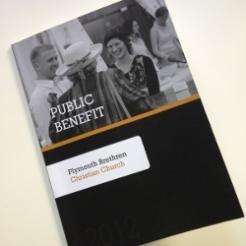Andrew Hind looks at implications of the Charity Commission's ruling on the Plymouth Brethren and what this means for the public benefit test.
The Charity Commission’s decision last month to register a Plymouth Brethren church meeting hall as a charity, combined with the Charity Tribunal’s previous decision in the 2011 independent schools’ case, have made many question whether the public benefit test has any substance.
Charity Finance readers who are as long in the tooth as me will remember the seminal 2001 report entitled For the public benefit? This was produced, after three years of deliberation, by NCVO’s Charity Law Reform Advisory Group, chaired by the late Winifred Tumim.
The Tumim Committee made the case for a change in the legal definition of charity, to make it clearer to the public what is precious and unique about our sector, and to bolster public trust in charity for the 21st century.
These ideas duly found their way into primary legislation a decade ago, in the 2004 Charities Bill – which, in time, became the Charities Act 2006, now 2011.
The cornerstone of the new legislation was the much-heralded public benefit test. It would no longer be presumed that organisations advancing education or religion, or those relieving poverty, were operating for the public benefit – instead they would have to show this was the case in the same way as every other charity in England and Wales.
The Charity Commission’s guidance says clearly that a charity must “satisfy both the ‘benefit’ and the ‘public’ aspects” of the test.
To satisfy the ‘benefit’ aspect, any detriment or harm which results from the charity’s activities “must not outweigh the benefit”. The Commission’s advice on the ‘public’ aspect is also very straightforward: the organisation’s activities “must benefit a sufficient section of the public” and must not “exclude the poor”.
Unfortunately, it now appears that – in practice – would-be charities find it all too easy to meet both parts of the test.
The ‘public’ aspect of the test was examined when the Independent Schools Council challenged the Charity Commission’s guidance on fee-charging charities in 2011. Many people wonder how a charitable school charging very high fees can meet the test of not “excluding the poor”.
A lily-livered Charity Tribunal ruled that such a school “must not exclude from benefit those that cannot afford the fees”, but they failed to set any minimum threshold, declaring only that “provision to this group must go beyond a token level”.
Little susbstance to the test
Now the ‘benefit’ aspect of the test has also been examined – and, again, a cart and horses has been driven through what many hoped had become a stronger public benefit environment.
In the Plymouth Brethren case the Commission found that the doctrine and practices of the Brethren caused “detriment and harm” to family members who are physically separated during disciplinary processes, and to individuals and their children who are unsupported when they leave the church. It also concluded that these practices may have adverse consequences for the wider community.
But despite concluding that these ‘disbenefits’ were “in real danger of outweighing” the benefits arising from the Brethren’s religious activities, the Commission nevertheless decided that the public benefit test had been passed.
So ten years on from the Charities Bill, where does that leave us? Sadly, it appears that ‘public benefit’ means you don’t have to support very many members of the public and you can generate an awful lot of disbenefit; yet you can still be a charity.
How much longer will the public support a sector that is now such a broad church that its distinctive features are becoming increasingly difficult to identify?
Andrew Hind is editor of Charity Finance.









